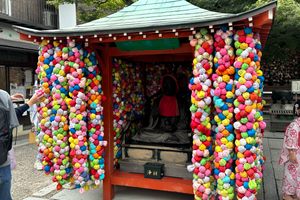
Yasaka Kōshin-dō is a distinctive temple in Kyoto’s Higashiyama district, close to the city’s famous Kiyomizu-dera pagoda. Yasaka Kōshin-dō, as a rare example of a Kōshin temple, presents a cultural and religious tapestry of Buddhist, Taoist, and Shinto elements.
Yasaka Kōshin-dō’s most iconic feature is its vibrant kukurizaru, small balls of bright fabric bearing wishes and confessions. These colourful kukurizaru are gathered in garlands, creating stunning walls of color around the temple. Though pretty, each kukurizaru represents a bound monkey whose hands and feet have been restrained, symbolising restraint from undesirable behaviour. According to Kōshin belief, by presenting your desire in such a way, your wishes will be granted and your self-control will improve.
The temple’s unique, monkey-inspired, kukurizaru fulfil a similar role to ema, the wooden plaques commonly found in other Japanese shrines and temples, which are also inspired by animals. Ema, meaning “picture-horse,” are so named since horses were considered the messengers and vehicles of Kami (Shinto deities).

